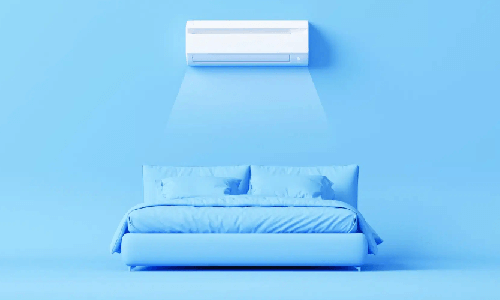What is an Air Conditioning System and How Does It Work?
Table of Contents

Air conditioning and HVAC systems, whether wall-mounted or portable, offer many benefits including saving on your energy bill with eco-friendly efficiency and improving the air quality in your home, but how does air conditioning actually work? You may be surprised to learn that air conditioners don’t actually bring in cold air from outside. Instead, they simply circulate the air in your home, adjusting it to the temperature you require.
What is an Air Conditioning System?
An air conditioning system cools and dehumidifies air by circulating refrigerant through a cycle of evaporation and condensation. It absorbs heat from the internal atmosphere and releases it outside, lowering the indoor temperature and humidity levels, maintaining a desired temperature.
Here’s how air conditioning works:
- The indoor AC unit absorbs air from the room into the air conditioning system.
- The air is then drawn over the refrigerant-filled evaporator pipes within the system, which are filled with hot or cold refrigerant, depending on the mode that has been selected by the user.
- As the air blows over the pipes, it either absorbs warmth or is cooled by the pipes, with the excess heat or cold being emitted outside by the outdoor unit via heat transfer within the refrigerant.
- The now cooled or warmed air continues moving through the system and is blended back with the existing air in the building as it flows back into the room, adjusting and maintaining the temperature/humidity to the level you require.
- This means the air is always being close-circulated as well as filtered, so fewer bacteria and contaminants can enter your home, making it cleaner and safer from outside pollutants.
Types of Air Conditioning Systems
There is not a one-size-fits-all air conditioner solution, so it is key to know which type would work best for your home or workplace.
Split Unit Air Conditioners
A split air conditioner system is composed of two main components: an outdoor unit and an indoor unit. These units are connected by electrical cables and refrigerant tubing and are one of the most popular systems around thanks to their efficiency and ease of installation. The external unit contains the compressor, condenser coil and the fan. The compressor pumps the refrigerant through the system and the condenser coil releases the absorbed indoor heat. The indoor unit comprises of the evaporator coil and a fan and is responsible for distributing the cooled air.
Multi-Split Air Conditioners
Multi split system air conditioners function similarly to standard split unit air conditioners but allow multiple indoor units to connect to a single external unit. This provides individual temperature control for separate rooms. The external unit houses the compressor and condenser, responsible for the refrigeration cycle, and the internal units all contain an evaporator and a fan. The outdoor unit compresses the refrigerant which flows to each internal unit, where an expansion valve regulates the refrigerant into its evaporator coil. When a room’s temperature goes above or below the thermostat setting, the corresponding unit reacts.
Portable Air Conditioners
A portable air conditioner is a self-contained unit that is ideal for cooling single rooms or areas where traditional window or split AC systems are not an option. All necessary components are included within the one unit that can be easily moved between rooms. A portable air conditioner is the ideal solution when you need supplemental cooling, temporary space temperature regulation, targeted cooling, emergency cooling or whilst trying to sleep.
Central Air Conditioning
Common in Europe and the US, central air conditioner systems work by circulating air through supply and return ducts. It all begins when the thermostat detects the indoor temperature is higher than the desired setting. The refrigeration cycle then commences, and the air is cooled through the compression, condensing, expansion and evaporation process. Internal air is drawn into the system through the return ducts, passes over the cold evaporator coil, where the refrigerant absorbs heat, and is then pushed back into the room through the supply ducts. The cycle continues until the temperature matches the thermostat setting.
But What About Heating?
An air conditioner system doesn’t have to be for only cooling your home on hot days as some models can also provide heat in the winter months. Reverse cycle air conditioners, also known as heat pumps, can raise the internal air temperature to the desired level by reversing the flow of refrigerant, meaning you can precisely control the comfort of your home throughout the year.
What is the Heating/Cooling Cycle?
The heating cycle is the reverse of the cooling cycle explained above. This process works by extracting heat from the outside air and transferring it indoors. This system is extremely efficient and even works when the external temperature is low. Having permanently controlled, temperate air is the ideal way to maintain home comforts, with the added benefit of it being highly cost-effective in the long run.
What is an Air Conditioning System and How Does It Work?
In the summer months we all like to enjoy the warmer weather and longer evenings, but as much as we like the nicer weather the heat can also cause discomfort inside our homes and workplaces. This is where an air conditioning system can really help combat the heat in summer and even provide heating in winter too! To find out more about air conditioning systems, running costs and efficiencies too, feel free to get in touch with one of our experts who will be more than happy to answer any air conditioning-related queries you might have.
Share:
More Posts








